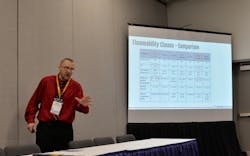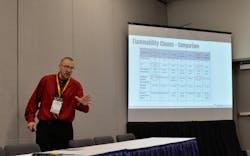In December 2020, the American Innovation and Manufacturing (AIM) Act of 2020 was enacted. The legislation authorizes the U.S. Environmental Protection Agency to address harmful hydrofluorocarbons (HFCs) by phasing down the production and consumption of HFCs, and facilitating the transition to next-generation refrigerants.
The HVACR industry is at the next phase — transitioning to A2L refrigerants. The controversy of A2Ls lies in their flammability potential, noted Jason Obrzut, director of industry standards and relations at ESCO. However, A2Ls have low toxicity and a lower flammability limit compared to older classes of refrigerant.
“Most A2L refrigerants are difficult to ignite,” he explained. “Common household items such as candles will not ignite an A2L refrigerant. It would need much higher concentration levels to do so. In the event of a fire, A2Ls are less likely to cause an ignition event to spread.”
Obrzut added that this new class of refrigerants must not be used for retrofit applications; they should be installed in new buildings only.
Technicians don’t need to fear A2Ls. However, they need to be aware of labeling and marketing requirements, such as the UL standards that require a label to be fixed on the refrigerant cylinder that must be filled out by the installing technician.
“If you use installation best practices today, you will have no difficulties in moving to these low global-warming-potential refrigerants,” he said.
About the Author

Kelly L. Faloon
Freelance Writer/Editor
Kelly L. Faloon is a contributing editor and writer to Contracting Business magazine, Contractor and HPAC Engineering. The former editor of Plumbing & Mechanical magazine, Faloon has more than 20 years experience in the plumbing and heating industry. She started a freelance writing and editing business in 2017, where she has a varied clientele.
Faloon spent 3 1/2 years at Supply House Times before joining the Plumbing & Mechanical staff in 2001. Previously, she spent nearly 10 years at CCH/Wolters Kluwer, a publishing firm specializing in business and tax law, where she wore many hats — proofreader, writer/editor for a daily tax publication, and Internal Revenue Code editor.
A native of Michigan’s northern Lower Peninsula, Faloon is a journalism graduate of Michigan State University. You can reach her at [email protected].

